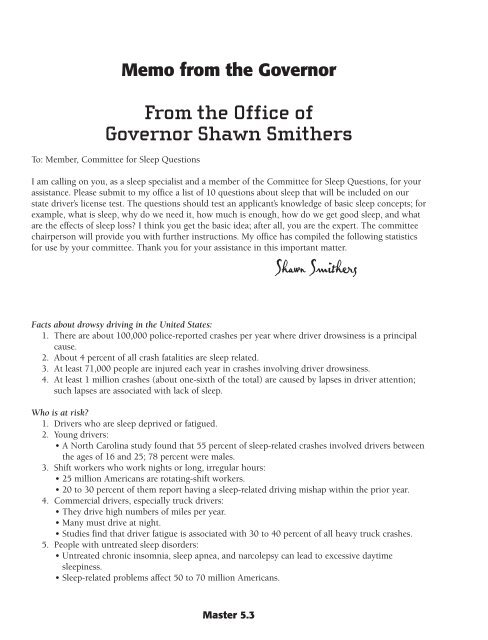Biological - NIH Office of Science Education - National Institutes of ...
Biological - NIH Office of Science Education - National Institutes of ...
Biological - NIH Office of Science Education - National Institutes of ...
You also want an ePaper? Increase the reach of your titles
YUMPU automatically turns print PDFs into web optimized ePapers that Google loves.
Memo from the Governor<br />
From the <strong>Office</strong> <strong>of</strong><br />
Governor Shawn Smithers<br />
To: Member, Committee for Sleep Questions<br />
I am calling on you, as a sleep specialist and a member <strong>of</strong> the Committee for Sleep Questions, for your<br />
assistance. Please submit to my <strong>of</strong>fice a list <strong>of</strong> 10 questions about sleep that will be included on our<br />
state driver’s license test. The questions should test an applicant’s knowledge <strong>of</strong> basic sleep concepts; for<br />
example, what is sleep, why do we need it, how much is enough, how do we get good sleep, and what<br />
are the effects <strong>of</strong> sleep loss? I think you get the basic idea; after all, you are the expert. The committee<br />
chairperson will provide you with further instructions. My <strong>of</strong>fice has compiled the following statistics<br />
for use by your committee. Thank you for your assistance in this important matter.<br />
Shawn Smithers<br />
Facts about drowsy driving in the United States:<br />
1. There are about 100,000 police-reported crashes per year where driver drowsiness is a principal<br />
cause.<br />
2. About 4 percent <strong>of</strong> all crash fatalities are sleep related.<br />
3. At least 71,000 people are injured each year in crashes involving driver drowsiness.<br />
4. At least 1 million crashes (about one-sixth <strong>of</strong> the total) are caused by lapses in driver attention;<br />
such lapses are associated with lack <strong>of</strong> sleep.<br />
Who is at risk?<br />
1. Drivers who are sleep deprived or fatigued.<br />
2. Young drivers:<br />
• A North Carolina study found that 55 percent <strong>of</strong> sleep-related crashes involved drivers between<br />
the ages <strong>of</strong> 16 and 25; 78 percent were males.<br />
3. Shift workers who work nights or long, irregular hours:<br />
• 25 million Americans are rotating-shift workers.<br />
• 20 to 30 percent <strong>of</strong> them report having a sleep-related driving mishap within the prior year.<br />
4. Commercial drivers, especially truck drivers:<br />
• They drive high numbers <strong>of</strong> miles per year.<br />
• Many must drive at night.<br />
• Studies find that driver fatigue is associated with 30 to 40 percent <strong>of</strong> all heavy truck crashes.<br />
5. People with untreated sleep disorders:<br />
• Untreated chronic insomnia, sleep apnea, and narcolepsy can lead to excessive daytime<br />
sleepiness.<br />
• Sleep-related problems affect 50 to 70 million Americans.<br />
Master 5.3

















